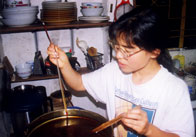We had difficulty finding pure methanol in Hong Kong, and eventually paid the very high price of US$10 per litre for 5 litres from a wholesale chemical supply company. It has to be 99% pure or better. (See Methanol suppliers)
We used sodium lye drain-cleaner (NaOH, sodium hydroxide) bought in small plastic containers at a local hardware store, not always very fresh. (We recommend using potassium hydroxide, KOH, instead of NaOH. See More about lye.)
We used 2 litres of methanol to 10 litres of vegetable oil, and 3.5 grams of NaOH per litre of oil -- 35 grams for 10 litres. (It's better to start with smaller one-litre test batches.)
We had to be quick measuring out the 35 grams of lye required. Lye is very hygroscopic, it absorbs moisture from the air; summer humidity in Hong Kong is usually about 80% at 30 deg C or more, and the lye rapidly got wet, making it less effective. (See More about lye.)
We mixed the lye with the 2 litres of methanol in a strong, heatproof glass bottle with a narrow neck to prevent splashing. It fumed and got hot, and took about 15 minutes to mix. (Use closed containers for mixing methoxide! See above, Mixing the methoxide.)
This mixture is sodium methoxide, a powerful corrosive base -- take full safety precautions when working with sodium methoxide, have a source of running water handy.
 Midori checks the temperature of the oil. |
We'd made a wooden jig with a portable vice clamped to it holding a power drill fitted with a paint mixer to stir the contents of the oil drum. This did a good job without splashing. (Not advised, it's dangerous to use sparking electric motors such as those in drills for processing with open containers. See "Simple 5-gallon processor" for a much better way.)
Stirring well, we carefully added the sodium methoxide to the oil. The reaction started immediately, the mixture rapidly transforming into a clear, golden liquid. We kept stirring for an hour, keeping the temperature constant. Then we let it settle overnight.
The next day we syphoned off 10 litres of biodiesel, leaving two litres of glycerine by-product in the bottom of the drum.
No comments:
Post a Comment